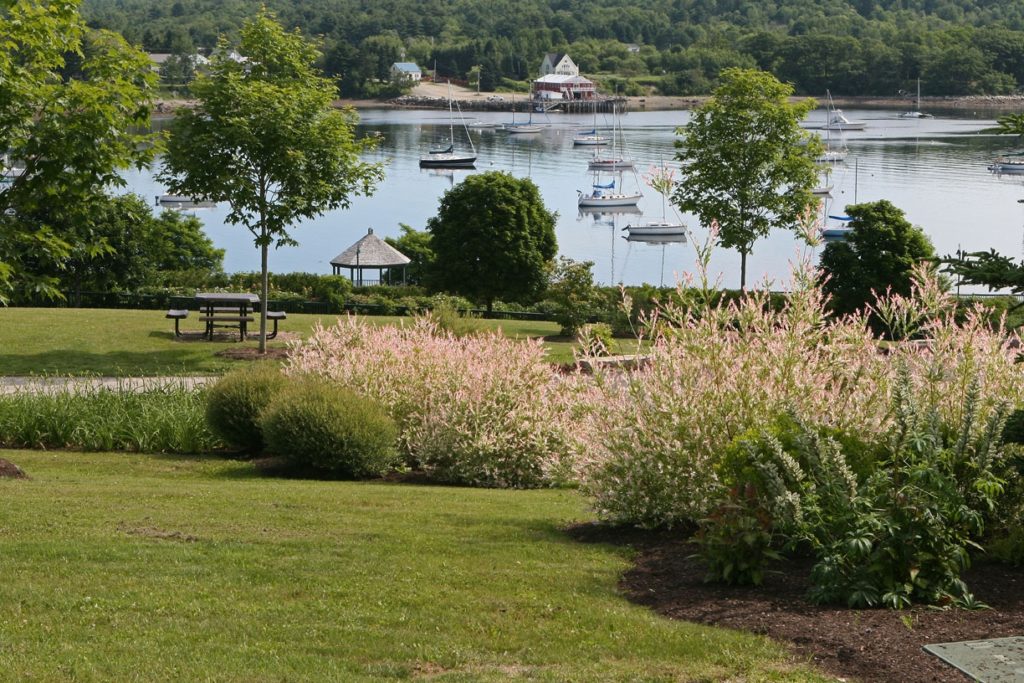Thriving public spaces contribute to the economic vitality of a community. Early New England communities often were built around a public common or public green. Initially, they might have served as grazing land for animals or a place for the exchange of goods. They often helped to organize and showcase public and civic buildings, and built the framework for a network of streets.
Many of these public and civic spaces are still present today, cherished by their communities. Examples of active public greens include Brunswick’s downtown common, which serves as a skating rink in winter and a farmers market and more in summer, and the privately donated park and waterfront land in Belfast which has become a downtown focal point.
Numerous examples exist up and down the coast, including Northport, Lincolnville, Camden, Rockport, Rockland and Wiscasset and in other Maine communities. These spaces often are magnets for social interaction, gathering spaces for events and public activities, and indeed a community meeting space that can serve as the hub of local information.
Communities across the U.S. are embracing the economic value of public spaces. Numerous articles have been written and economic research conducted that highlight the economic, personal health and social value of community public spaces. These spaces often became part of the community’s identity and its uniqueness. Friends of Midcoast Maine works to help communities identify these assets and build upon them for the long term.
Communities today work hard to take full advantage of the economic benefits of these public spaces by “programming” activities such as concerts, outdoor movies, yoga classes, performances, farmers markets and other events. This brings life into (or in some cases, back into) our downtowns and village centers. Communities that successfully capitalize on these spaces end up with healthier economies and more active healthier community members. When a community provides things to do, people are more likely to stay, relocate or return to that place.
Other communities work hard to retain or acquire new public spaces for the environmental benefits they bring. Passive recreation areas, parks and trails, green ways, waterfront access or wildlife areas offer a place to rejuvenate or relax after a day of work or school. They can offer healthy daytime activities for young families or older folks to enjoy. Many communities realize that opportunities for outdoor recreation attract young families and the younger millennial aged generation of 20- to 40-year-olds, age groups that are essential to the economic, social and political futures of our communities.
AARP, the largest organization serving retired people, has an entire website designed around place-making, parks and open spaces. It notes that by 2030, one in three Americans will be 60 or older and urges our communities to be ready. It notes that livable communities are destinations and the site highlights successful communities that provide public spaces and amenities for active living, including bike trails and bike shares, walking and other physical activity programs and even public gardens.
“Having places to go is important for people to stay engaged, socialize and not feel isolated,” AARP asserts. Several years ago, a Colorado community established a goal to make sure every community member could live within a ten-minute walk of a public park or open space.
Southwest Airlines is investing in public spaces and place-making.
“On the surface, it’s easy to look at great public places and see them as nothing more than well-designed physical locations. But beneath the surface, these places … are locations where community comes alive, where bonds among neighbors are strengthened and where a sense of belonging is fostered,” the company argues. “They are locations that spark economic development and drive environmental sustainability.”
So how does a community decide whether it is worth the expense to activate or acquire new civic or public spaces? What is the cost? What is the benefit? Is it worth the community investment? These are important and serious decisions that involve public trust and wise public investments by people working to steward our communities into the future.
A Knight Foundation report found that schools, healthcare and safe streets create strong communities where people want to live, work, play and invest. But even more, “community attachment” was an emotional quality that made people want to move and put down roots. They found that social offerings, openness and aesthetics are most related to community attachment in all the 26 communities studied.
If Maine communities want to build strong economies, ensure a vibrant and prosperous future and engage younger generations to stay here and lead our communities into the future, we must invest—in our youth, our communities and our places. And that means building, supporting and developing the cities and towns, the neighborhoods, the housing stock, the schools and the public places we need to successfully and healthily live, work, play and do business.
Jane Lafleur is executive director of the Camden-based Friends of Midcoast Maine and The Community Institute.





